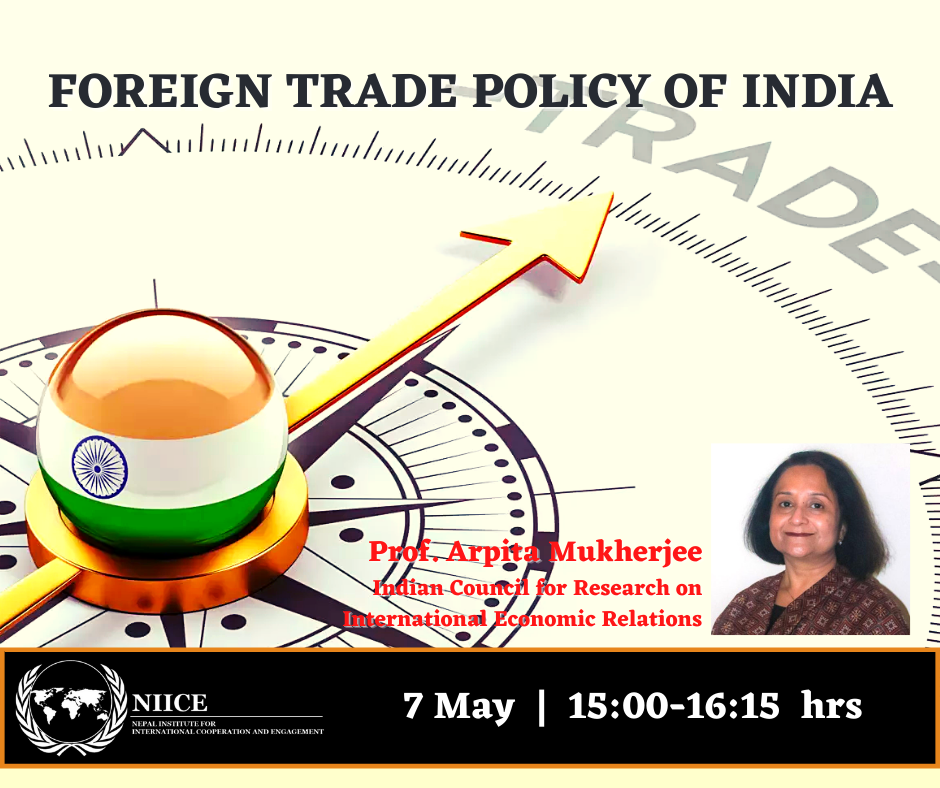
Foreign Trade Policy of India
Watch it on NIICE Nepal YouTube Channel
Event Report
Foreign Trade Policy of India
May 7, 2022
The webinar was about the foreign trade policy of India by Professor Arpita Mukherjee, who is an economics professor at the Indian Council for Research on International Economic Relations (ICRIER). She begins the presentation by explaining the concept of Foreign Trade Policy (FTP). FTP is a document, drawn by the Director General (DG) of Foreign Trade, which lays down a 5-year trade vision of the government as to what the country wants to do in terms of exports, imports, government policies, and strategies. Not only does FTP provides subsidies and incentives but it also aligns with the vision of the government. The FTP tries to capture how a country fits itself into the changing global scenario. It also highlights the gaps in the government policies and strategies and provides what needs to be done.
Prof. Mukherjee further explains it by stating the example of the last FTP 2015-2020 which was extended to 2021. The 2015-2020 FTP provided a framework for increasing trade, generating employment, and increasing value addition in the country, all aligned with the ‘Make in India’ programme. Two new schemes were also introduced: Merchandise Exports from India Scheme (MEIS) and Services Exports from India Scheme (SEIS), both exports linked incentives. The FTP 2015-2020 is also important because for the first time the impending digital technology was acknowledged for which D-Minimus was provided, meaning the minimum amount that can be sent duty-free.
The FTP also tried to streamline the process of self-certification by manufacturers of their Indian Manufactured Goods to avail certain incentives easily. It not only tried to upgrade and interlink infrastructure but also sought ways to support small and medium-sized industries in their exports. The FTP recognized the Micro, Small, and Medium Enterprises (MSME) clusters and came up with the ‘Niryat Bhandu Scheme’ to help clustered MSME link with the global value chain.
This FTP came out during one of the toughest times for India due to various reasons. Firstly, there was increased competition from countries like Vietnam and Cambodia which suddenly started exporting India’s export products like textile and food to key markets of the USA and European Union. Secondly, the Trump administration had increased policies of Protectionism and US put certain complications on imports of steel and other things from India. Thirdly, the US-China trade war was also problematic for India, as India-China relations did not work out the way India had foreseen.
There were also many issues with the FTP 2015-2020. Even though it provided many subsidies and incentives, it did not focus on skill development, quality standard, and upgradation. 90% of the incentives were not in compliance with the World Trade Organisation (WTO). It was a low-hanging fruit instead of a long-term enhancement of export competitiveness.
Compliance with WTO rules is an important aspect of an FTP. The WTO sees certain subsidies as trade-distorting, so it is important to impose disciplines on these subsidies. To achieve this, the WTO has established a set of rules to govern subsidies and export incentives in its member countries.
Prof. Mukherjee concludes the webinar by stating the current situation of India and the current FTP 2021-2026. Due to the pandemic not only did the economic growth fall but the per capita income also declined. India’s share in world exports is also 2% with the second highest countervailing duties. The Government of India also realized the problems and sought to rectify them. It came out with a new scheme called the Rotax Scheme which is the remission of duties and taxes on exports.
Prepared by Shriya Mishra, NIICE Intern

Recent Comments